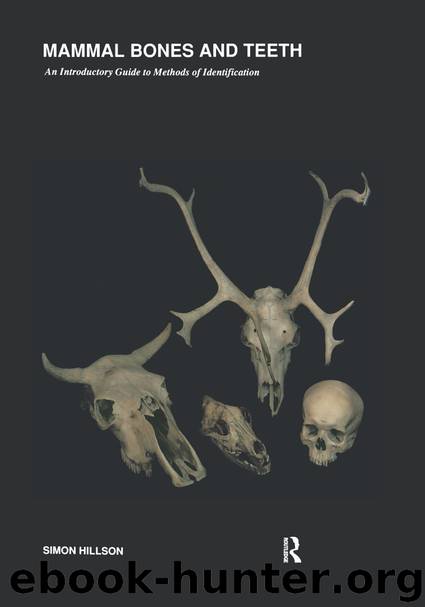Mammal Bones and Teeth: An Introductory Guide to Methods of Identification (UCL Institute of Archaeology Publications) by Simon Hillson

Author:Simon Hillson [Hillson, Simon]
Language: eng
Format: azw3
ISBN: 9781315424989
Publisher: Taylor and Francis
Published: 2016-06-15T16:00:00+00:00
Transverse processes
• Relatively thick lobes, bulging to caudal; horse.
• Thin, triangular plates, angled to caudal; bovids, cervids.
• Thin, square plates, not angled to caudal; pig.
• Narrow, finger-like, markedly angled to caudal; dog, cat.
• Small, broad lobes angled to cranial; human.
RIBS (FIG. 28)
Ribs, or fragments of them, are some of the commonest finds but are also some of the most difficult to identify. They may be divided into two main components – the long, curving body and the complex of joints and tubercles which make up the proximal articulation. This comprises a proximal head bearing twin joint facets (to articulate with pairs of facets on the bodies of neighbouring thoracic vertebrae), a neck connecting it with the body, and a tubercle which bears a small facet (to articulate with the facet on the transverse process of a thoracic vertebra).
Download
This site does not store any files on its server. We only index and link to content provided by other sites. Please contact the content providers to delete copyright contents if any and email us, we'll remove relevant links or contents immediately.
| Africa | Americas |
| Arctic & Antarctica | Asia |
| Australia & Oceania | Europe |
| Middle East | Russia |
| United States | World |
| Ancient Civilizations | Military |
| Historical Study & Educational Resources |
Underground: A Human History of the Worlds Beneath Our Feet by Will Hunt(12022)
Sapiens by Yuval Noah Harari(5293)
Navigation and Map Reading by K Andrew(5111)
The Sympathizer by Viet Thanh Nguyen(4305)
Barron's AP Biology by Goldberg M.S. Deborah T(4096)
5 Steps to a 5 AP U.S. History, 2010-2011 Edition (5 Steps to a 5 on the Advanced Placement Examinations Series) by Armstrong Stephen(3687)
Three Women by Lisa Taddeo(3353)
Water by Ian Miller(3126)
The Comedians: Drunks, Thieves, Scoundrels, and the History of American Comedy by Nesteroff Kliph(3039)
Drugs Unlimited by Mike Power(2544)
A Short History of Drunkenness by Forsyth Mark(2233)
DarkMarket by Misha Glenny(2158)
The House of Government by Slezkine Yuri(2158)
And the Band Played On by Randy Shilts(2127)
The Library Book by Susan Orlean(2041)
Revived (Cat Patrick) by Cat Patrick(1963)
The Woman Who Smashed Codes by Jason Fagone(1929)
Birth by Tina Cassidy(1864)
The Absolutely True Diary of a Part-Time Indian by Sherman Alexie(1856)
